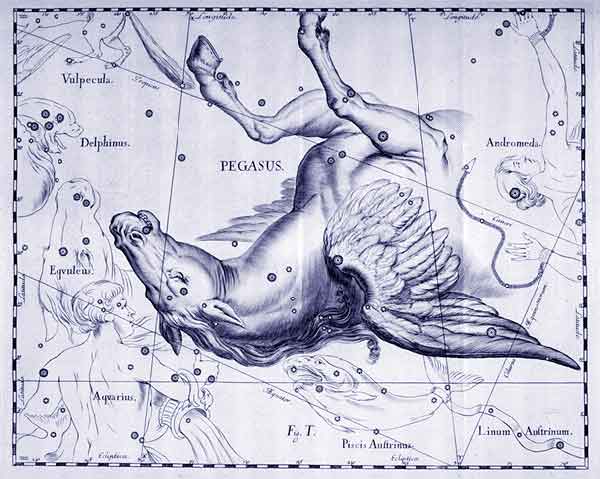
MYTHOLOGY
The Pegaso comes represented in sky as a winged horse turned upside down visible for the superior half and although that represents the seventh greater constellation in absolute. The astronomers are usual to associate this constellation to the so-called square of the Pegaso, formed from stars alpha (Markab = "saddleback" in Arab), beta (Scheat = "calf"), gamma (Algenib = "wing" or "flank") and alpha Andromedae (Sirrah = "navel", reported to Andromeda): this last one came considered part of the Pegaso, when it had still probably not been "cut" to half; today this star belongs to Andromeda but it still constitutes visual part of the Pegaso. They turn several legends around this square; the fundamental reason of the provoked interest has had to the particular position of four stars regarding the axes of the solstices and of the equinoxes therefore like they appeared in fifth millenium A.C. (age of the Mesopotami, the first giving to us a mitological testimony). In that time in fact the square was found between the winter advanced extremity of the straight one that combined the two solstices and the central point them of the Milky Way that visually was introduced like an arc that combined the two equinoxes (the constellations on which found the Sun to the beginning of the Spring and the Autumn, that is Gemelli and Sagittario). The Mesopotami saw in this extraordinary position the charismatic center of the sky in which the universal harmony was melted. But today the extremities of the "cross season", with the more times remembered precession of the equinoxes, are change. The myth more diffused of this constellation is undoubtedly that Greek, that it sees the Pegaso as the fruit of the violences of Poseidone on Medusa (you see Perseo). The "delivery" but did not happen in the traditional way: when Perseo cut the head to them, the Pegaso flew outside from the neck with to the warrior Crisaore. After the birth it is narrated that from a blow of its hoof on the mount Elicone is been born the Ippocrene source (“source of the horse”, exactly) whose waters gave the inspiration of the MUSE. Tied to this event it is also the rappresentation to head in down of the horse in the sky regarding the other neighbors: it would have been turned over from the Greek astronomers so that in their sky (of 5000 years ago) during the night of solstice of summer the hooves were to contact with the Moon in order to generate the divine source that filled up the vase of the Aquarius and overflowed the celestial river (the Milky Way, than indeed it constitutes one of the sources of inspiration for poets and artists). With the exception of how much it is believed, the Pegaso was not the horse of Perseo, but mainly it was mounted from an other great hero, Bellerofonte. This last one, son of Glauco, came down from the real house of Corinto: because of an involuntary homicide, he came send away from the city but it came then purified from the King Preto. To the court of these but Queen Antea fall in love of the hero, which it refused it for respect of the King. Offended it, she told to its husband of to have been object of presumed violences from Bellerofonte, expecting to kill it. The King, not having the courage to kill in first person a host, sent Bellerofonte from the King of Lycea - Iobate - with a message that described (false) the nottles of this last one, praying of the killing. Also Iobate did not have the courage to complete the killing, so that it ordered to the hero to kill the Chimera, a apparently invincible monster with the front part of dredges and with the head of flaming goat. Therefore Bellerofonte before facing the monster succeeded to capture the Pegaso, to horse of which putted in the mouth of the Chimera a large ball of lead that, melted for the heat of the breath, come down in the body having some bowel. Iobate, displeased of its victorious return, ordered to the hero to kill the Solimi and the Amazons allied: a childs' play for our knight, which, from the high of its "aerial fliing" seeded sturdy knows that they breaked the witness enemy. Now resigned, the King then decided to make to kill directly it from its men, which obviously came massacred. To this point Iobate, having the suspicion that the hero was protect from the Gods, began to believe in its innocence and in fact of it it had confirmation from the direct story of Bellerofonte. Mortified for the happened one, the King granted in spouse the its daughter and name it heir to the throne of Lycea. The knight began to gives too many airs and came punished from Zeus during its attempt to catch up Mount Olympus in rump to the Pegaso. A "divine" tafano in fact pricked making it to fall in a bramble from a considerable height: from then the hero it remained lame, blind, single and cursed for for the rest of its life. The Pegaso instead succeeded equally to catch up Mount Olympus where it came lodged in the divine stables and used from Zeus like carrier of its lamps. Finally, in order to celebrate it, Zeus eternally it placed it in the firmament.